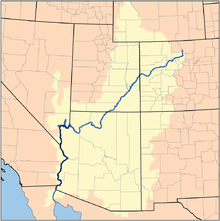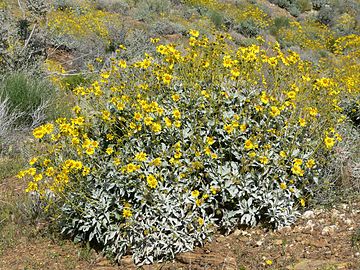Lower Colorado River Valley
This article needs additional citations for verification. (February 2020) |


The Lower Colorado River Valley (LCRV) is the river region of the lower
It is commonly defined as the region from below
reservations.Ecology
Some of the highest air temperatures in North America are recorded in the LCRV, rivaling
The LCRV extends about 350 miles (563 km) from Hoover Dam to the
Fauna
Flora
The Lower Colorado River Valley has unique plant communities because it is the most arid part of the desert and it has the highest temperatures, in excess of 120 °F (49 °C) during the summer. The low humidity means that most plants must have mechanisms that deal with severe water loss through evaporation. The soils tend to be typical
Dominant plants in the valleys are low shrubs such as Ambrosia dumosa (white bursage) and Larrea tridentata (creosote bush). Over half of the floral diversity comprises annual species, with even higher percentages in drier habitats.[3] Vulnerable species and plant communities include saltbush/wolfberry flats, saguaro, nightblooming cereus cacti, tamarisks, barrel cactus, Sonoran panicgrass, and acuna cactus (a subspecies of Sclerocactus johnsonii).[4]
-
Yucca brevifolia (Joshua tree)
-
Abronia villosa (sand verbena)
-
Eriogonum inflatum (desert trumpet)
-
Encelia farinosa (brittlebush)
Threats
The Lower Colorado River Valley subregion of the Sonoran Desert bioregion has multiple threats. Some major threats include
List of major cities and communities
- Laughlin, Nevada in Clark County, Nevada
- Needles, California in San Bernardino County
- Bullhead City, Arizona
- Mojave Valley, Arizona
- Lake Havasu City, Arizona
- Silver Cliffs, Arizona/California
- Vidal, California
- Parker, Arizona
- Blythe, California
- Quartzite, Arizona
- Winterhaven, California in Imperial County, California
- Yuma, Arizona in Yuma County, Arizona
- San Luis, Arizona
- San Luis Río Colorado, Sonora
Complete list of towns, areas, etc, north to south
|
Nevada–California–Baja California side
|
Arizona–Sonora side
|
Feeder-valleys, or included small valleys
|
Nevada–California–Baja California side
|
Arizona–Sonora side
|
References
- ^ "Lower Colorado River Valley" section, Center for Sonoran Desert Studies; [1]
- OCLC 4053799.
- ^ a b "Sonoran Desertscrub – Lower Colorado River Valley by Mark A. Dimmitt :: ASDM Sonoran Desert Digital Library". Desertmuseumdigitallibrary.org. Retrieved 15 September 2018.
- ^ a b Ecological threats, Lower Colorado River Valley






